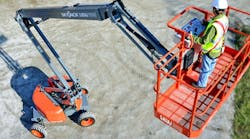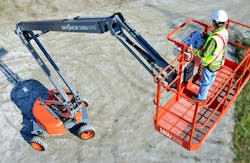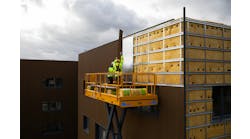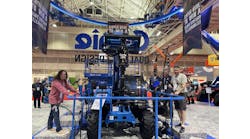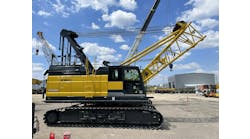The Participants:
Brad Boehler, president, Skyjack
Matt Fearon, president, Terex AWP
Jeff Ford, global product director, JLG Industries;
Alexandre Saubot, chief operating officer, Haulotte Group
What are some of the new technological developments in your company’s equipment?
Jeff Ford: JLG Ground Support recently launched a new JLG Mobile Analyzer, a diagnostics tool designed to give technicians remote access to program, troubleshoot, calibrate, or customize JLG equipment performance. The JLG Mobile Analyzer, currently available in English and Spanish with 11 additional languages by the end of 2013, is a Wi-Fi-enabled evolution of the JLG Analyzer Kit. Features include:
- Allows for an extended operator range of up to 150 feet
- Compatible with Apple iOS 5.0 and up, plus Android API 8 and up
- Works with JLG products compatible with the JLG Analyzer Kit, as well as new JLG products with Advanced Design Electronics
- The JLG Wireless Access Module is interchangeable between machines (Note: it can only be connected to one mobile device at a time)
- Displays full description read-outs instead of scrolling text
- Analyzer training is included as part of all JLG factory training
Matt Fearon: Genie has introduced several really innovative and unique developments recently. At the recent Bauma tradeshow in Munich, for instance, we introduced our new Genie SX-180 telescopic boom, which breaks through all industry records at 180 feet. It’s the largest of its kind in the market, and the boomlift is suited for applications in the oil and gas industries, commercial construction, industrial construction and maintenance, and general maintenance.
The machine is actually designed to be driven at full height, and our newly designed X-chassis extends and retracts to provide both stability on the job and a narrow profile for transport. The machine requires no over-width or over-height permits allowing it to be easily transported on a truck. This same X-chassis design is also used on our new Genie ZX-135 articulating boom introduced at ARA earlier this year. This allows our big booms to share many design features providing parts and operating commonality.
Another development is our new SmartLink software. SmartLink is a new control system designed and built internally for the next generation of Genie equipment. It provides end users with intuitive and easy-to-use controls that are common across all units and makes operation more precise with multi-speed controls.
The patented diagnostic system allows the customer to diagnose exact problems by simply connecting a standard Ethernet cable to any internet-ready computer. For customers, this solves the most difficult portion of troubleshooting a faulty machine. This system was built from day one with customer input, team-member engagement and a goal of solving real world issues.
The SmartLink system is currently available on the Genie GR, GRC, Quick Stock and all slab scissors.
Brad Boehler: Our equipment continues to be simply reliable, providing the best return on investment to our customers, based on original acquisition cost, cost of operation, ease of maintenance and residual value. Right now the market is focused on re-fleeting, reducing fleet age. We expect this to take some time after the long period of significantly reduced capital spending by rental companies. In a recovering market, rates are still lower than many would like to see so there is a slight preference to models with better ROI for the rental companies. Some niche models like the ZB2044 have gained some popularity and attractiveness of rental rates have been noted as one of the drivers.
Alexandre Saubot: Easy maintenance, reliability and overall performance. A lot of small things rather major breakthroughs. Are we able to make machines better for the user and for the technician? We’re always trying to make it better and more efficient than what we had before.
The aerial industry has gone through some dramatic ups and downs. It was on quite a high growth trajectory, then the recession hit and sales dropped dramatically, and now they are going back up again. What is your reaction to these cyclical shifts?
Fearon: The aerial industry, and construction for that matter, is cyclical in nature. That is not going to change. That said, we are off to a great start to 2013 and feel this is the third year of a five- to seven-year growth cycle for North America. Europe, Middle East, Africa and Russia (EMEAR) is starting to look up too, and by the time North America starts to feel another cyclical downturn, I feel that we will be buoyed by the EMEAR market and newer markets like China, Brazil, India and Southeast Asia.
Saubot: Cyclical shifts are part of the business, which always will be cyclical. In 2009 all over the world business was very strongly down at the same time. But it’s a cyclical business and one of our responsibilities is to manage those cycles. My view of the market is that there will still be growth the next year but it will be a slower pace than what we have seen the past two years; the one exception is Europe, which will remain low.
Europe is the only country that in the past two years the recovery has been very low, so there is still some room to do better, but the confidence is not there, so it is very difficult to forecast for Europe.
Boehler: The aerial industry has always been cyclical in nature, at least for OEMs. But the recession was a perfect storm of events, aligning the ‘natural’ down cycle of the industry with a number of external factors most notably the residential construction crash and the financial market issues that presented new hurdles for companies to access capital. We forecast and expect a normal amount of cyclicality but the timing of the great recession made things challenging for a couple of years. During extreme troughs your focus shifts from maintaining and maximizing market penetration to maintaining a skilled team.
Ford: Most recently, JLG introduced the new and innovative SkyGuard aftermarket accessory. Developed after extensive research and testing, the SkyGuard sensor, when activated by approximately 50 pounds (23kg) of force, stops all functions in use at the time. The reverse functionality is the only feature of its kind in the market. After stopping the machine, it temporarily reverses, or “undoes” most functions that were in use at the time of activation for less than a second. The control system automatically accesses the functions in use by the operator at the time of SkyGuard activation and — for a small period of time — is able to reverse that sequence, with the exception of certain functions.
Fearon: There is a growing awareness about the importance of aerial safety in our industry. We recently introduced our new Lift Pro online operator training at the ARA show. By offering this course online, a much broader range of individuals now have access to the opportunity to become a qualified operator, and a wider range of Genie customers who don’t currently offer this type of program will have the ability to provide high-quality operator training to their end users. By increasing the percentage of operators who have received quality training through this program, we are all contributing to the improvement of overall aerial work platform industry safety.
Our customers have been extremely positive about not only promoting safety and providing quality training to their customers, but the time savings and revenue potential as well. Our new program is being met with enthusiasm and we feel confident about its growth. We are also developing a new telehandler online training program that should be available soon.
Saubot: I’m not sure I can say much greater, but we are pushing on this subject. There is a strong requirement for the manufacturer to make machines that will be safer and safer. For us the strategy is continuing to improve the reliability of the machine. That’s part of the long-term development we have to work on, to provide more safety without reducing the pleasure of working with the machine. That’s the manufacturer’s responsibility.
Boehler: The industry is becoming more effectively involved in promoting the safe use of all aerial equipment. Standards in all parts of the world do continue to move forward with more stringent requirements, which are being met in different ways by various manufacturers.
What about the work of IPAF and the efforts of various organizations to promote aerial safety? Is this a positive development?
Ford: JLG continues to be active with IPAF, as well as new organizations in developing markets, like the China Occupational Safety Health Association, which is focused on safe work practices in China.
Fearon: All of us are in support of any offering that promotes safety in the aerial industry, and furthers the message that training is vital for safe operation of aerial equipment.
Saubot: The good thing about IPAF is that they can listen to everyone. In the case of any kind of accident or any kind of problems they really try to look at how we can improve safety. You bring everybody to the table, you have users, you have manufacturers, and you have rental companies. You have a lot of people at the table that are concerned about this issue.
Boehler: IPAF and other organizations are making a difference with respect to the safe use of aerial equipment. Skyjack considers effective operator training as the primary method of reducing injury associated with the use of this equipment, and is actively working with some major rental companies to distribute the new IPAF/AWPT eLearning program throughout the U.S.
It would seem that the aerial work platform still has room for growth in the sense that people are still discovering the value of AWPs around the world, and this is true even in more mature markets, such as the United States. How would you describe the growth of the aerial market in recent years and what do you expect to see in the coming years?
Ford: Currently the AWP business is recovering with strong replacement demand in mature markets like North America. We expect to see strengthening in construction and continued adoption in emerging markets, which will expand the use of AWPs into new markets, height classes and applications.
Fearon: The North American rental market has continued to grow. Although we did experience the economic downturn, usage and awareness of aerial products in general continue to spread. We have been seeing that our customers started to refresh their fleets in late 2010 and continued through 2012. We are now beginning to see signs of fleet growth in North America. Overall, the economy is improving, rental companies are growing stronger, interest rates are low, housing is coming backand fleet ages are still high. We expect these positive trends to continue for the next few years.
Globally, the EMEAR countries are starting to make a comeback in spots like in Northern Europe, whereas Southern countries like Spain and Greece are still struggling. We are beginning to see large rental companies begin to refresh their fleets despite the economic uncertainty. China is coming along slowly; Brazil will be gaining momentum due to the World Cup and the Olympics and India is starting to develop as well.
Overall, we are definitely in the “upturn” now. These are the good times.
Boehler: We consider the growth we are seeing now as recovery by way of re-fleeting and expect it to continue for the coming years. There is certainly room for true growth getting to levels of rental penetration and overall equipment populations higher than pre-recession levels.
Saubot: That will continue to grow, that will be one of the growth trends on the market that we see more and more. I am pretty confident that we will continue to see additional penetration and additional product awareness all around the world. That is what we are working hard on, to promote the product and product awareness ina lot of emerging countries. I think this trend will continue but it is difficult to measure how fast it will go. rer
